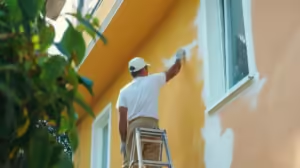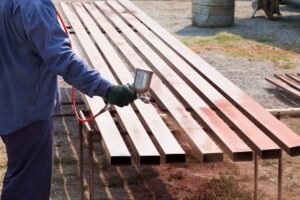Introduction to UV Resistance
Mithila paints, known for their vibrant colors and intricate designs, originate from the Mithila region of Bihar, India. These traditional artworks are an integral part of the local culture, reflecting the area’s rich heritage and artistic expression. The history of Mithila painting is deeply intertwined with the community’s social and spiritual life, often influenced by religious themes and mythology. Through generations, these traditional forms of expression have been passed down, maintaining their relevance in contemporary art.
The unique characteristics that define Mithila paints include their use of natural pigments derived from plants, minerals, and other organic materials. This approach not only ensures vibrant hues but also adheres to ecological practices, aligning with an increasing global emphasis on sustainability in art and manufacturing. Mithila artists traditionally apply these pigments using simple tools, such as fingers, brushes, or twigs. This technique results in intricate patterns, characterized by fine lines and repetitive motifs that narrate stories or represent local customs.
Historically, Mithila paintings adorned the walls of homes, particularly during festive occasions and personal events like weddings. While primarily a decorative art form, these paintings also served functional purposes, including illustrating religious stories or symbolizing fertility and prosperity. The shift towards commercial production in recent years has seen Mithila paints transition from wall decors to various products such as textiles, pottery, and packaging, making them accessible to a broader audience. Despite this evolution, traditional methods and themes remain central to the identity of Mithila paints, preserving their cultural significance while adapting to modern aesthetics.
What is UV Resistance?
Ultraviolet (UV) rays are a component of sunlight that is responsible for various damaging effects on materials exposed to them for extended periods. These rays fall within the electromagnetic spectrum and are divided into three categories: UVA, UVB, and UVC. Among these, UVA rays penetrate deeper into the skin and materials, while UVB rays are primarily responsible for superficial damage. UVC rays are mostly absorbed by the Earth’s atmosphere and do not pose a significant threat to materials on the surface.
In the context of paints, UV rays can lead to degradation over time, causing fading, discoloration, and a breakdown of the paint film. This degradation can significantly diminish the aesthetic appeal and protective qualities of the paint, especially in outdoor applications where the paint is frequently exposed to sunlight. As a result, the presence of UV resistance in paint formulations is crucial for preserving both the visual integrity and the durability of the painted surfaces.
UV resistance refers to the ability of a paint to withstand the adverse effects of UV radiation without fading or deteriorating. This resistance is achieved through the incorporation of specialized additives and pigments that can absorb, reflect, or scatter UV rays. Enhancers like UV stabilizers play a pivotal role in prolonging the life of the paint, ensuring it remains vibrant and effective in protecting underlying surfaces from environmental elements.
Maintaining paint quality and durability over time is critical for both aesthetic and functional reasons. When a protective coating holds up well against UV rays, it not only improves the longevity of the exterior materials but also reduces maintenance costs associated with repainting or surface treatment. Therefore, understanding and prioritizing UV resistance in the manufacturing of Mithila paints is essential for achieving superior performance in diverse environments.

Importance of UV Resistance in Paint Manufacturing
UV resistance plays a pivotal role in the realm of paint manufacturing, particularly in the context of Mithila paints, which are deeply rooted in cultural significance and artistic expression. For artists and craftspeople, the longevity of their work is of utmost importance, as it directly correlates with the vibrancy and preservation of the intricate designs and colors that characterize Mithila art. Paints that are not UV resistant are prone to fading when exposed to sunlight, ultimately diminishing the visual appeal and integrity of the artwork over time.
The influence of ultraviolet (UV) radiation on paint formulations can lead to the breakdown of pigments and binders, which affects both the appearance and performance of the paint. By developing UV-resistant paints, manufacturers can ensure that the colors remain stable and true, even under prolonged exposure to sunlight. This is particularly essential for outdoor murals and decorative items intended for public display, where the risk of color degradation is considerably higher due to constant light exposure.
Furthermore, UV stability significantly impacts the creative expression of artists. When artists are confident that their chosen paints can withstand the harsh effects of sunlight, they can push their creative boundaries without fear of compromising the quality of their work. This assurance not only encourages innovation but also fosters a greater appreciation for the traditional art form of Mithila painting, as it allows artists to preserve their culture’s rich artistic heritage.
In summary, ensuring UV resistance in Mithila paints is crucial for maintaining the artwork’s longevity, protecting against fading, and enhancing the overall creative expression of artists and craftspeople. As such, paint manufacturers must prioritize the incorporation of UV-resistant properties in their formulations to support the vibrant and enduring tradition of Mithila art.

Materials That Enhance UV Resistance in Mithila Paints
Understanding the composition of Mithila paints is crucial for achieving enhanced resistance to ultraviolet (UV) rays. Several materials and additives can be strategically incorporated into the paint formulation to significantly improve its performance against UV degradation. Among the most critical components are pigments, binders, and other additives that collectively contribute to the paint’s UV stability.
Firstly, the choice of pigments plays a vital role in UV resistance. Organic pigments, while often vibrant, tend to have poor stability under UV exposure. Conversely, inorganic pigments, such as titanium dioxide and iron oxide, exhibit excellent UV shielding properties. These inorganic pigments not only provide opacity and color fastness but also reflect harmful UV light, thereby protecting the underlying layers of paint and the substrate. Selecting a balanced mixture of pigments can help achieve both aesthetic appeal and prolonged durability.
Additionally, binders are essential for enhancing the adhesion and flexibility of the paint. The incorporation of high-performance binders, such as acrylics or alkyds, helps form a resilient film that resists cracking and peeling when exposed to sunlight. Some modern binders are specifically formulated to contain UV absorbing additives, which further protect the paint film from degradation caused by prolonged exposure to sunlight. This synergy between binders and pigments creates a stronger barrier against UV rays.
Lastly, other additives such as UV stabilizers and hindered amine light stabilizers (HALS) can be integrated into Mithila paints to bolster UV resistance. These additives absorb or dissipate UV radiation, preventing it from penetrating the paint film and damaging the substrate. Moreover, incorporating antioxidants can help in reducing the likelihood of chemical degradation caused by UV exposure, thereby significantly extending the lifespan of the paint. Overall, a careful selection of these materials is essential for formulating Mithila paints that are not only visually appealing but also durable against UV radiation.
Testing UV Resistance in Mithila Paints
Testing the UV resistance of Mithila paints involves a combination of controlled laboratory assessments and real-world exposure evaluations. These methods are vital in ensuring that the paints we manufacture can withstand prolonged exposure to sunlight while maintaining their aesthetic and functional properties. The testing process begins in the laboratory, where specific standards and equipment are utilized to simulate UV radiation and environmental conditions.
One common method used in laboratory tests is the use of accelerated weathering machines, which replicate the effects of sunlight, humidity, and temperature fluctuations. This technology allows us to gauge how well a paint performs over extended periods under varying conditions. During these tests, Mithila paints are applied onto test panels, which are then placed in the weathering apparatus. The results offer data on color retention, gloss measurement, and surface integrity, which are crucial benchmarks for assessing UV stability.
In addition to laboratory assessments, real-world exposure testing is an essential component of evaluating UV resistance. This involves applying Mithila paints to structures or surfaces in outdoor environments to monitor their performance over time. By exposing the paints to actual sunlight, rain, and seasonal changes, we gain insights into their durability and resistance to UV degradation in real-life conditions. Field tests not only supplement lab results but also help identify any unforeseen issues that may arise during extended use.
Standards such as ASTM D4587 and ISO 16474 provide guidelines for the testing of UV resistance in coatings, ensuring that the performance of Mithila paints aligns with industry benchmarks. This comprehensive approach, combining both laboratory and field evaluations, enables us to ascertain the UV resistance of our products effectively, ensuring they meet quality and performance standards for long-lasting beauty and protection.

Innovations in UV Resistance for Mithila Paints
The realm of Mithila paints has witnessed significant advancements aimed at enhancing UV resistance, an essential attribute that ensures the longevity and vibrancy of these decorative coatings. Recent innovations emphasize the incorporation of novel materials and advanced technologies that bolster the paint’s ability to withstand the detrimental effects of ultraviolet radiation. These improvements not only cater to aesthetic preferences but also address the increasing demand for durable solutions in both residential and commercial applications.
One of the most notable advancements in UV resistance for Mithila paints is the development of high-performance synthetic polymers. These polymers enhance the paint’s formulation, offering improved adhesion and weather resistance. Innovations such as UV-absorbing additives are now integrated into the paint mixes, which significantly mitigate the degrading impact of sunlight. This integration has proven to be vital, particularly in regions with intense sunlight exposure, where paint longevity is often compromised.
Moreover, researchers are exploring the utilization of nanotechnology to create UV-resistant paints. By incorporating nanoparticles that reflect UV rays, manufacturers are able to produce paints that not only maintain their aesthetic appeal for extended periods but also reduce energy consumption in buildings by minimizing heat absorption. This eco-friendly approach is gaining traction, aligning with global trends toward sustainability and material efficiency in manufacturing processes.
Additionally, the ongoing research into bio-based pigments signifies a move toward greener formulations. These pigments, derived from natural sources, exhibit inherent UV stability, thereby enhancing the performance of Mithila paints while reflecting a commitment to environmental responsibility. The amalgamation of traditional artistry with contemporary science is paving the way for a new era in Mithila paints, ensuring they remain a timeless choice for both their cultural significance and technical prowess.
Challenges in Achieving UV Resistance
Creating UV-resistant Mithila paints involves a multitude of challenges that manufacturers must navigate. One of the most pressing difficulties relates to economic constraints. Many manufacturers operate on limited budgets, preferring to minimize costs associated with raw materials, production processes, and research and development. This reluctance to invest can hinder the adoption of advanced technologies and higher-quality ingredients, both of which are essential for achieving effective UV resistance. Consequently, paints may fall short in performance, leading to rapid degradation when exposed to sunlight.
Sourcing quality materials also presents a significant challenge. The efficacy of UV-resistant paints largely depends on the performance of specific chemicals and additives that provide the necessary protection. However, procuring these high-quality materials can be difficult due to environmental regulations, supply chain disruptions, or simply unavailability in certain regions. These factors can negatively impact the production capabilities of Mithila paint manufacturers, resulting in products that lack the desired durability in outdoor applications.
Moreover, there exists a delicate balance between traditional practices and modern requirements in the realm of paint manufacturing. Mithila art is immensely revered for its cultural significance and traditional methods, which often prioritize aesthetics over durability. Manufacturers grapple with integrating contemporary principles of durability, including UV resistance, without compromising the artisanal quality that defines Mithila paints. This tension between maintaining cultural authenticity and meeting modern performance standards adds an additional layer of complexity to the production process.
These challenges necessitate innovative solutions and a collaborative approach among stakeholders in the industry. By addressing both economic and material sourcing issues, as well as finding a middle ground between tradition and modernity, manufacturers can enhance the UV resistance of Mithila paints while preserving their unique cultural origins.
Case Studies of Successful UV Resistant Mithila Paints
Mithila paints, known for their vibrant colors and intricate designs, have gained recognition not only for their aesthetic appeal but also for their enhanced durability, particularly in terms of UV resistance. Several manufacturers have successfully developed UV resistant formulations that have displayed impressive performance. One notable case is that of a prominent Mithila paint manufacturer in Bihar, India. This company invested in research and development to produce a line of UV resistant paints designed specifically for exterior applications. By utilizing advanced polymers and UV absorbers, the manufacturer optimized their paint to withstand the degradation caused by prolonged sun exposure.
Feedback from customers who have used this UV resistant paint has been overwhelmingly positive. Many report that the paint maintained its vibrant colors significantly longer than traditional paints, highlighting its superior retention of hue and gloss even after several seasons of exposure. This case illustrates the potential benefits of embracing modern technology in traditional crafting methods, providing both aesthetic and functional advantages.
Another noteworthy example comes from an artisanal producer who specializes in eco-friendly Mithila paints. This manufacturer adopted a different approach by incorporating natural UV filters derived from botanical sources into their formulations. This innovative strategy not only enhanced the paint’s resistance to UV rays but also aligned with their commitment to sustainability. Customer reviews have praised this paint for its unique finish and reduced environmental impact, selecting it as a preferable alternative in both residential and commercial projects.
These case studies underscore the advancements being made in Mithila paint manufacturing, particularly in increasing UV resistance. By leveraging technological improvements and sustainable practices, manufacturers are able to meet the growing demand for durable and increasingly effective UV resistant paints, thereby affirming the viability and relevance of traditional Mithila craftsmanship in contemporary applications.

Conclusion and Future Directions
In the realm of Mithila paints, understanding UV resistance is crucial for both manufacturers and consumers. UV resistance not only enhances the longevity of these paints but also preserves the vibrant colors that characterize Mithila art. As discussed in this blog post, this resistance is achieved through a combination of high-quality raw materials, innovative formulations, and rigorous testing procedures. Manufacturers who prioritize UV resistance in their production processes can significantly improve product quality and customer satisfaction.
Moreover, consumers are increasingly seeking out paints that not only meet aesthetic and artistic demands but also provide durability against fading and weathering. The importance of UV resistance extends beyond mere aesthetics; it involves considerations of sustainability and environmental impact. Paints with higher UV resistance can minimize the frequency of repaints, thereby reducing waste and the lifecycle impact associated with production and disposal.
Looking ahead, the future of UV resistance in Mithila paints appears promising. Ongoing research and development are focused on the creation of new compounds and formulations that enhance UV blocking capabilities. Advances in nanotechnology and the use of biodegradable materials could revolutionize the industry, leading to eco-friendly options that do not compromise on performance. Additionally, manufacturers may explore the integration of digital technology to monitor and enhance the UV properties of paints during every stage of the production process.
As these trends unfold, it is imperative for both manufacturers to stay attuned to evolving consumer preferences and for scholars to keep investigating innovative solutions. The collaboration between artists, manufacturers, and researchers will be pivotal in ensuring that Mithila paints remain not only a significant cultural artifact but also a competitive product in the global market. Ultimately, the commitment to enhancing UV resistance will serve to fortify the legacy of Mithila art for generations to come.

